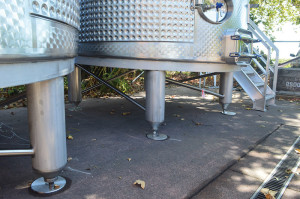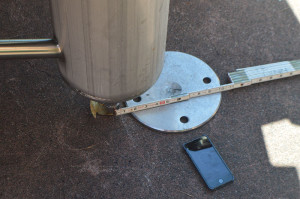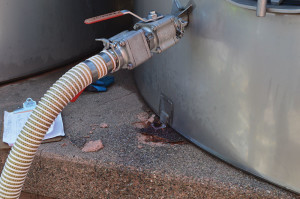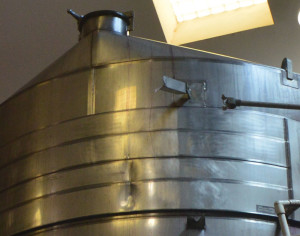On August 24, 2014, a magnitude 6.0 earthquake occurred northwest of American Canyon, California. The earthquake was located between two faults: the West Napa Fault and the Carneros-Franklin Fault near the north shore of the San Pablo Bay. Structural damage was most severe in the downtown Napa region, where a number of unreinforced masonry (URM) buildings were located. Damage to residential building construction was also observed surrounding the downtown region, and became less severe farther away from town. Damage to vineyards and wine storage facilities was focused mainly on damage to stainless steel storage and fermentation tanks, and damage to the wine storage barrels due to racks collapsing.
This article focuses on the cylindrical steel tank damage observed at wineries after the Napa Valley earthquake. The tank damage discussed in this article was not unique to the Napa Valley Earthquake. This type of damage has been documented after previous earthquakes around the world. Large-scale testing and numerical models have been developed to demonstrate the behavior of cylindrical steel fluid-filled tanks during earthquakes. Although damage to cylindrical steel tanks from earthquakes has been well documented, and research has demonstrated better anchorage systems may improve the seismic performance, it seems the design and construction of these tanks used in the wine industry has not advanced with these known improvements.
Discussions with selected wineries in Napa after the earthquake demonstrated that the performance objectives of the steel tanks in the wine industry differs from those in other industries that use cylindrical fluid-filled steel tanks (water, oil, chemical). Wineries experienced buckling of the tank walls, anchorage failures, and racking of the tanks against one another. However, this type of damage was not unique to the Napa Valley Earthquake. This damage has been exhibited in previous earthquakes in California and around the world: the 1977 San Juan earthquake, 1980 Greenville-Mt. Diablo earthquake, 1984 Morgan-Hill earthquake, 1989 Loma Prieta earthquake, 2003 San-Simeon earthquake, 2010 Maule earthquake, and the 2013 Marlborough earthquake. Documentation of damage after each of these earthquakes demonstrates that buckling of steel tank walls and anchorage failure occurred in tanks that were full with fluid and anchored to the ground.
The February 2010 Maule Earthquake affected a region in which 70% of the wine production of Chile takes place. The ground motion measured during the earthquake was about 0.35g, and damage fell mostly in three categories: (1) damage to steel fermentation tanks, (2) wine storage barrels falling off their racks, and (3) spilled unprocessed wine.
Stainless steel tanks can be either leg supported, or continuously supported with a flat base. Damage was observed to both of tank-types. The legged supported stainless steel (LSSS) tanks are used often to ferment and store small volumes of high quality wine. These tanks are usually between 350 to 1765 cubic feet (10 to 50m3) in capacity. The damage to the LSSS tanks as a result of the Maule Earthquake included buckling of the supporting legs caused by axial resultant forces from the overturning moment, and movement of the tank resulting in the tank falling off of the supporting concrete base when the LSSS tanks were not anchored to the concrete base.
Buckling of LSSS tanks was not observed after the Napa Valley Earthquake; however, movement of unanchored LSSS tanks was documented. During the Maule Earthquake, LSSS tanks that had enough room to move and were unanchored performed better than the anchored legged tanks. However, when the tank moved, there was damage to the piping systems. Movement of the tanks was observed up to 8 inches (20cm), which is consistent with the movement of the tanks observed during the Napa Valley Earthquake and shown in Figures 1a & b.
Those tanks that are continuously supported with a flat bottom are typically larger storage and fermentation tanks, and are called flat bottom tanks. The flat bottom tanks are also anchored to concrete slabs. Damage to these tanks observed after the 2010 Maule Earthquake included anchorage failure and buckling of the stainless steel tank wall. Anchorage failures were caused by insufficient edge distance, insufficient number of anchors, corrosion of the anchors, insufficient effective anchorage length, inadequate resistance of the concrete foundation surrounding the anchor, and lack of proper steel reinforcement surrounding the anchor. Anchorage failure typically occurred in conjunction with the diamond buckling shape failure of the steel tank walls. The steel tank walls buckled in two ways: (1) diamond shape buckling, and (2) “elephant foot” failure. The diamond shape buckling failure was more common in tall, slender tanks, whereas the “elephant foot” failure could be observed in the squat tanks that were full of liquid. The damage that was observed during the Napa Valley Earthquake was mainly the diamond shape buckling failure of the stainless steel wall in conjunction with anchorage failure of the tanks to the concrete base and is shown in Figure 2.
Another common failure that was observed after the 2010 Maule Earthquake was failure at the connection of the piping to the tanks. This type of failure occurred when the tank shifted or rocked during the earthquake, and because of the racking of the piping system against the wall of the tanks during the earthquake. Both conditions were observed after the Napa Valley Earthquake as well. Buckling of tank walls at the top courses occurred during the Maule earthquake due to the suction effect when there was rapid loss of liquid inside of the tank. This did not occur in tanks without a roof, as no suction effect occurred. This type of observed damage could have been prevented if a relief valve had been present.
The 1977 San Juan earthquake was a magnitude 7.4 earthquake located 50 miles (80km) north-east of downtown San Juan. The observed tank damage included buckling of steel tank walls and anchorage failure at the connection of the tanks to the concrete base. All of the tanks examined demonstrated “elephant foot” tank wall bulging. This damage was observed at the first course from the bottom of the tank, or just above the joint from the first to the second course of the tank. Anchorage failure was observed in all of the tanks as well. Rehabilitation efforts occurred after the earthquake for these anchorage failures, and this included strengthening of the existing anchorage system in addition to reducing the amount of liquid in each tank. Four of the tanks having severe tank wall buckling fully collapsed during to the earthquake. In addition to the tank shell bulging, some of the tanks exhibited weld rupture at the joint of the bottom course with the angular plate used as part of the anchorage system. This caused loss of liquid inside of the tank.
The tank damage observed during the 1977 San Juan earthquake is the same as the damage documented through the 2014 Napa Valley earthquake, as well as the 2010 Maule earthquake. Anchorage failure is a common type of damage observed in all of the previous earthquakes where reconnaissance teams examined the tanks. This type of failure was also documented by the news after the 2013 Marlborough earthquake in New Zealand.
“The tanks are bolted to the slabs with earthquake bolts and the bolts did what they were designed to do. They stretched, and in some cases broke, but that’s what they are design to do – they kept the tanks upright”.
– The National Business Review NZ Winegrowers chief executive Philip Gregan
The anchor bolts are not meant to dissipate the energy from the earthquake, but rather prevent the tank from rocking off the foundation. The above quote demonstrates that the anchor bolts served their purpose during the earthquake, but with unintended damage. Previous research and developed analytical procedures would allow engineers to design tanks to prevent this behavior. Anchorage failures occurred after the 2014 Napa Valley earthquake, mainly in tanks that were full. Figure 3 demonstrates some examples of anchorage failures observed after the Napa Valley earthquake. Figure 3a shows a corroded anchor, Figure 3b shows an anchor that failed due to insufficient anchorage length and edge distance.
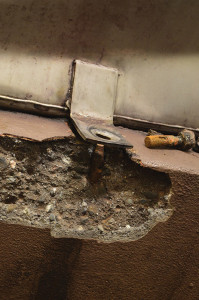
Figure 3. Anchorage failure of fermentation tanks (a) corroded anchor used to attach flat bottom tank to concrete base, (b) anchor failure at edge of concrete base support.
In addition to movement of legged tanks, buckling of the steel tank wall, and anchorage failures after the 2014 Napa Valley earthquake, there was also damage to the top of the steel tanks. This was not due to the suction effect as seen during the 2010 Maule earthquake, rather due to the pounding of catwalk systems against the tank walls. Figure 4 demonstrates an example of this pounding. The catwalk in this portion of the warehouse had been removed because it was damaged; however, the denting of the tank at the top is seen.
The base shear and overturning moment have two components: convective, and impulsive. When the liquid inside of the tank moves in unison with the tank, the resulting stresses are the impulsive component. The sloshing of liquid inside of the tank against the tank walls causes the convective component. The impulsive component controls during the shorter periods, whereas the convective component controls during the long periods of seismic excitation. For a majority of tanks (0.3 < H/r < 3, where H is the liquid height within the tank and r is the tank radius), the first convective and first impulsive modes of vibration generally account for 85 to 98% of the total liquid mass in the tank. For tall tanks (H/r > 1), the remaining liquid mass vibrates at higher impulsive periods, and for squat tanks (H/r [pmath]<=[/pmath] 1) the remaining liquid mass vibrates at higher convective periods.
The first simplified models developed took both the impulsive and convective dynamic contributions into account. However, the first models developed assumed only horizontal ground movement. This research determined there is a portion of the liquid in the tank that moves in a long period, while the remainder of the liquid moves rigidly with the tank walls. The liquid that moves with the tank wall (impulsive) moves with the same acceleration as the ground during an earthquake. The convective (translatory, sloshing) behavior is a result of the impulsive pressures. The impulse period is the major contributor to the base shear and overturning moment of the tank during an earthquake. However, these first models assumed the tank walls were rigid and did not deform during their own motion. This assumption caused unconservative base shear and overturning moment predictions using these simplified models.
Simplified models produced based upon the work performed by Housner and Jacobsen demonstrated the tank walls will deform and cause the impulse motion to be larger than originally determined. The flexibility of the tank walls can cause the impulsive motion to be greater than the ground acceleration. These models have shown that the liquid inside the tank and the flexibility of the tank walls can amplify the base shear and overturning moments during an earthquake. In addition, the models have demonstrated that rigid or flexible foundations can significantly affect the dynamic response of these tanks. These models have shown the maximum allowable compressive stresses reported in codes should be reevaluated to take into account vertical compressive forces and the combination of vertical compressive stress, hoop stress, and bending stress to prevent yielding of the tank walls.
These models were compared with experiments performed on cylindrical fluid-filled tanks. These tests highlighted the need for further investigation into anchorage design for anchored tanks during an earthquake, and thicker tank walls. The damage to the tanks observed during the experiments was consistent with damage viewed in previous earthquakes.
After the 2010 Maule Earthquake, the simplified method presented by Malhotra et al. [16] was used to determine the allowable stress for the damage steel tank walls [11]. The tanks that were examined after the earthquake were used as examples, and calculations were performed to understand if allowable stress using a simplified model would have predicted failure in the tank walls. These results demonstrated that those tanks that exhibited tank wall buckling during the 2010 Maule Earthquake exceeded the allowable stress in the tank wall using the Malhotra et al. simplified model.
Analytical modeling on base isolation systems has progressed for the application to LNG tanks. These systems significantly reduce the seismic base shear and overturning moment of the tanks by 60 to 80% FEM modeling was compared with simplified methods with good agreement for preliminary design. These research projects highlight the need for similar projects for liquid-filled cylindrical tanks for the wine industry. LNG tanks are double-walled tanks with the outside wall typically post-tensioned concrete, as compared to the single-walled steel tanks used in the wine industry.
While the simplified methods of analysis provide tools for engineers to evaluate the base shear and overturning moments of fluid-filled cylindrical steel tanks during seismic events, these methods of analysis are for the elastic response analysis. Many vineyards are located in regions of strong ground motion (i.e. Chile, California, New Zealand). The forces obtained from the elastic response analysis are very large and reduced by factors up to 3 to obtain design forces for the tanks. Previous earthquakes and experimental research has demonstrated that fluid-filled cylindrical steel tanks will respond with non-linear behavior and sustain damage during a strong seismic event. However, there currently are no methods of analysis for non-linear behavior of these tanks. Therefore it is very difficult to predict and quantify the damage that will be sustained by these tanks during an earthquake with strong ground shaking. The engineering community has demonstrated the benefits of implementing relevant research results when applicable to LNG tanks and petroleum filled tanks. There is a great need for practical non-linear analysis methods for the design of fluid-filled cylindrical steel tanks. This research needs to conform to the expected performance objectives of the vineyards.▪
REFERENCES
G. C. Manos, “Evaluation of the earthquake performance of anchored wine tanks during the San Juan, Argentina, 1977 earthquake,” Earthquake Engineering and Structural Dynamics, vol. 20, pp. 1099-1114, 1991.
A. Niwa and R. W. Clough, “Buckling of cylindrical liquid-storage tanks under earthquake loading,” Earthquake Engineering and Structural Dynamics, vol. 10, pp. 107-122, 1982.
S. W. Swan, D. D. Miller and P. I. Yanev, “The Morgan Hill Earthquake of April 24, 1984–Effects on Industrial Facilities, Buildings, and Other Facilities,” Earthquake Spectra, vol. 1, pp. 457-568, 1984.
EERI Reconaissance Team, “Loma Prieta Earthquake Reconnaissance Report,” Earthquake Spectra, vol. 6, pp. 189-238.
R. K. Goel, December 22, 2003 San Simeon Earthquake, 2003.
Risk Magement Solutions (RMS), 2003 San Simeon, California, Earthquake, RMS, 2003.
F. Zareian, C. Sampere, V. Sandoval, D. L. McCormick, J. Moehle and R. Leon, “Reconnaissance of the Chilean Wine Industry Affected by the 2010 Chilean Offshore Maule Earthquake,” Earthquake Spectra, vol. 28, no. S1, pp. S503-S512, 2012.
wine-searcher, “Quakes shake Marlborough wineries,” 2013 July 22. [Online]. Available: www.wine-searcher.com/m/2013/07/quake-shakes-marlborough-wineries.
Radio new Zealand, “Wineries suffer further damage from latest quake,” 2013 August 19. [Online]. Available: www.radionz.co.nz/news/rural/217295/wineries-suffer-further-damage-from-latest-quake.
The National Business Review, “Marlborough wine region comes through earthquake well,” 13 August 2013. [Online]. Available: www.nbr.co.nz/article/marlborough-wine-region-comes-through-earthquake-well-bd-144638.
E. Gonzales, J. Almazan, J. Beltran, R. Herrera and V. Sandoval, “Performance of stainless steel winery tanks during the 02/27/2010 Maule Earthquake,” Engineering Structures, vol. 56, pp. 1402-1418, 2013.
USGS, San Juan, Argentina Earthquake of November 23, 1977, U.S. Geological Survey, 1977.
G. S. Leon and A. M. Kausel, “Seismic analysis of fluid storage tanks,” Journal of Structural Engineering, vol. 112, pp. 1-18, 1986.
R. Peek and P. C. Jennings, “Simplified analysis of unanchored tanks,” Earthquake Engineering and Structural Dynamics, vol. 16, pp. 1073-1085, 1988.
AWWA, Welded Carbon Steel Tanks for Water Storage (AWWA D100-11), American Water Works Association, 2011.
P. K. Malhotra, T. Wenk and M. Wieland, “Simplified procedure for seismic analysis of liquid-storage tanks,” Structural Engineering International, vol. 3, pp. 197-201, 2000.
G. W. Housner, Dynamic Analysis of Fluids in Containers Subjected to Accelerations, in Nuclear Reactors and Earthquakes, Washington, D.C., W.S. Atomic Energy Commission TID-7024, 1969, p. Appendix F.
L. S. Jacobsen, “Impulsive hydrodynamics of fluid inside a cylindrical tank and of fluid surrounding a cylindrical pier,” Bulletin of the Seismological Society of America, vol. 39, no. 3, pp. 189-204, 1949.
A. S. Veletsos and J. Y. Yang, “Earthquake response of liquid storage tanks,” in Proceedings of the Second Engineering Mechanics Specialty Conference, ASCE, Raleigh, 1977.
M. A. Haroun, Dynamic Analysis of Liquid Storage Tanks, California Institute of Technology, Pasadena, 1980.
M. A. Haroun and G. W. Housner, “Seismic design of liquid-storage tanks,” Journal of Technical Councils, vol. 107, no. 1, pp. 191-207, 1981.
A. S. Veletsos and Y. Tang, “Soil-structure interaction effects for laterally excited liquid-storage tanks,” Journal of Earthquake Engineering and Structural Dynamics, vol. 19, no. 4, pp. 473-496, 1990.
API, Welded Steel Tanks for Oil Storage (API 650), American Petroleum Institute, 2012.
G. C. Manos and R. W. Clough, Further study of the earthquake response of a broad cylindrical liquid-storage tank model (UCB/EERC-82/07), Earthquake Engineering Research Center, University of California Berkeley, Berkeley, 1982.
A. Niwa, Seismic behavior of tall liquid storage tanks (UCD/EERC-78/04), Earthquake Engineering Research Center, University of California Berkeley, Berkeley, 1978.
V. P. Gregoriou, S. V. Tsinopoulos and D. L. Karabalis, “Dynamic analysis of liquified natural gas tanks seismically protected with energy dissipating base isolation systems,” in Computational Methods in Structural Dynamics and Earthquake Engineering, Corfu, Greece, 2011.
I. P. Christovasilis and A. S. Whittaker, “Seismic analysis of conventional and isolated LNG tanks using mechanical analogs,” Earthquake Spectra, vol. 24, no. 3, pp. 599-616, 2008.

